Coinbase vs Robinhood vs BitGlide: Best U.S. Crypto Trading App Face-Off
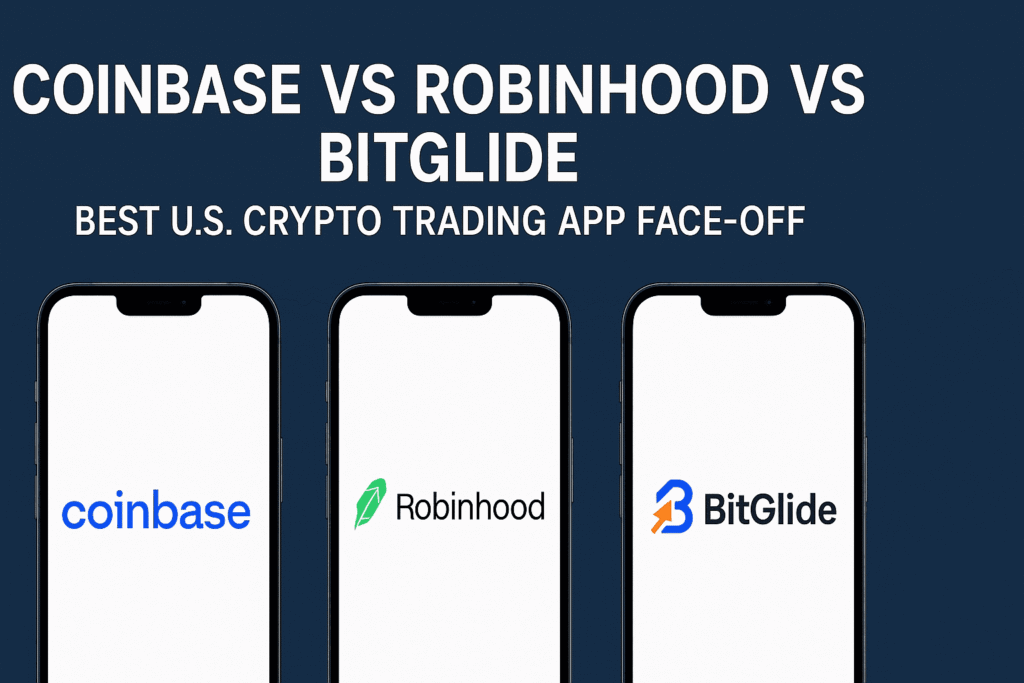
Follow Us On Social Media
Intro – Coinbase vs Robinhood vs BitGlide
The crypto world in 2025 is bigger, faster, and more accessible than ever. Whether you’re just dipping your toes into Bitcoin or thinking about earning passive income through staking, one of the biggest decisions you’ll make is choosing the right trading app.
With dozens of platforms available in the U.S., we’re putting three of the most talked-about apps to the test:
🔹 Coinbase – the long-time trusted name in crypto.
🔹 Robinhood – the app that made trading stocks and crypto feel like swiping through Instagram.
🔹 BitGlide – a rising star in 2025 that’s attracting attention with its high APYs and sleek interface.
This guide will help you compare these platforms across 5 key areas that matter most for beginners:
- APY returns (staking rewards)
- Fees and hidden costs
- Real user reviews
- Safety and regulations
- Ease of use and app experience
Let’s dive in and find out which app might be perfect for your crypto journey!
🔁 APY: Which App Pays You the Most?
One of the most exciting parts of crypto investing is earning APY (Annual Percentage Yield) through staking. It’s like earning interest on your crypto while doing nothing — a great option for long-term holders.
Coinbase

Coinbase remains one of the most trusted U.S.-based platforms when it comes to staking. In 2025, they offer around:
- 6.0% APY on Ethereum (ETH)
- 4.5% on Cardano (ADA)
- 3.8% on Solana (SOL)
They auto-stake assets for you and distribute rewards directly to your wallet.
Robinhood
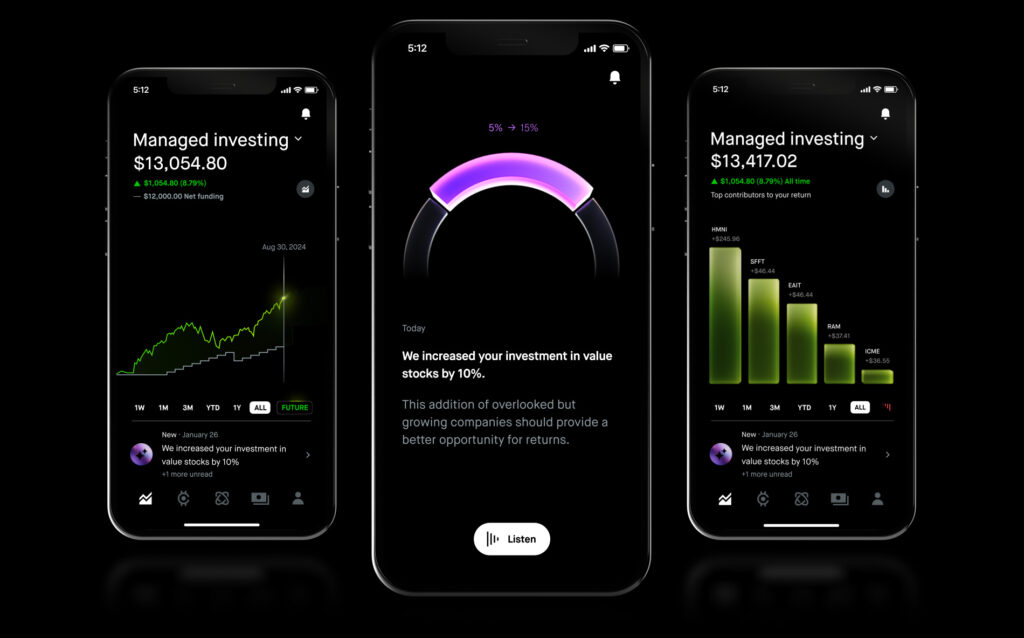
Unfortunately, Robinhood still doesn’t support staking in 2025. You can buy and hold crypto, but you won’t earn any rewards while holding assets.
BitGlide
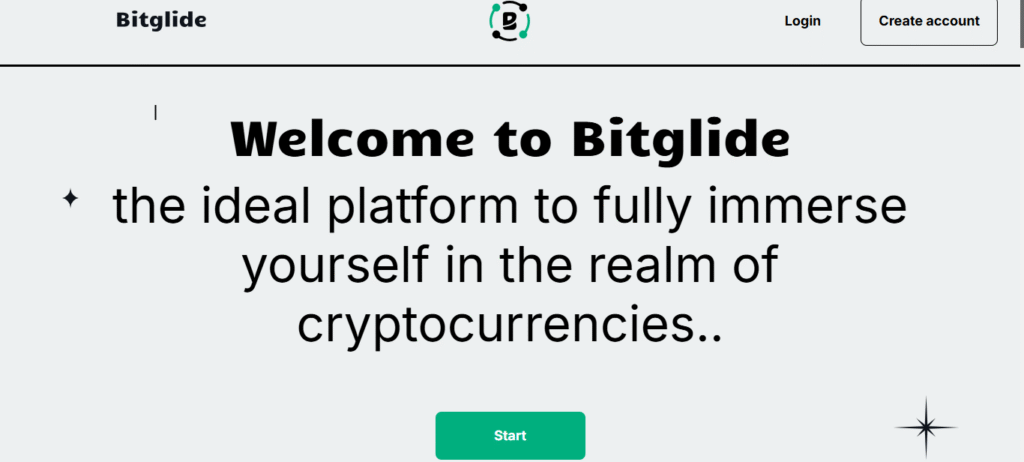
BitGlide is aggressively competing in the staking space. It offers:
- 8.5% APY on Polkadot (DOT)
- 7% on Solana (SOL)
- Other tokens have dynamic yields that change weekly
Their model targets younger investors looking for high passive income potential. BitGlide even offers flexible lock-in periods, allowing you to withdraw early (with minor penalties).
Real-World Example:
Say you stake $1,000 in Ethereum:
- Coinbase: ~$60/year
- BitGlide: Up to $85/year (if staked in DOT)
- Robinhood: $0
✅ Takeaway:
If earning from your crypto matters, Coinbase and BitGlide are your go-to platforms. Coinbase is safe and simple; BitGlide is high-yield but less proven. Robinhood is great for short-term traders, but not for passive earners.
💸 Fees: Who Takes the Smallest Bite?

Fees are often the hidden killers of your profits. Whether you’re buying your first $100 in Bitcoin or trading $1,000 worth of altcoins, it’s important to know what you’re being charged — and why.
Coinbase
Coinbase has long been criticized for high fees. In 2025:
- 1.49% fee for bank transfers
- 3.99% for debit card purchases
- 0.5% spread on conversions
If you buy $500 in Bitcoin using a debit card, you could lose almost $20 in fees.
The upside? You’re paying for premium security, beginner-friendly UI, and compliance with U.S. regulations.
Robinhood
Robinhood advertises commission-free trading, but there’s a catch:
- They don’t charge a direct fee, but instead use “payment for order flow” — and add a slight markup on crypto prices
- You may buy Bitcoin at a slightly higher price than real-time market rate
While casual traders may not notice the difference, advanced users might lose out over time, especially with frequent trades.
BitGlide
BitGlide currently wins the fee war. In 2025:
- $0 trading fees
- No spreads or markups (at least for now)
- Free withdrawals for most tokens
They’re targeting growth, so they’re absorbing costs. But this could change as the company scales.
✅ Takeaway:
- Robinhood wins on paper with no commissions
- BitGlide is the best value today, especially for budget-conscious users
- Coinbase is the most expensive, but you’re paying for peace of mind and U.S. regulatory backing
You should look into this blog – Phantom Wallet Review 2025: Is It the Best Solana Wallet for NFTs and Staking?
📱 UI Experience: Which App Is the Easiest to Use?
For beginners, user experience can make or break your confidence in crypto. A cluttered interface, confusing buttons, or hidden features can be intimidating — especially when real money is involved. So let’s break down how each app feels in real use, especially if you’re new to the world of Bitcoin or Ethereum.
Coinbase: Clean, Beginner-Focused Design
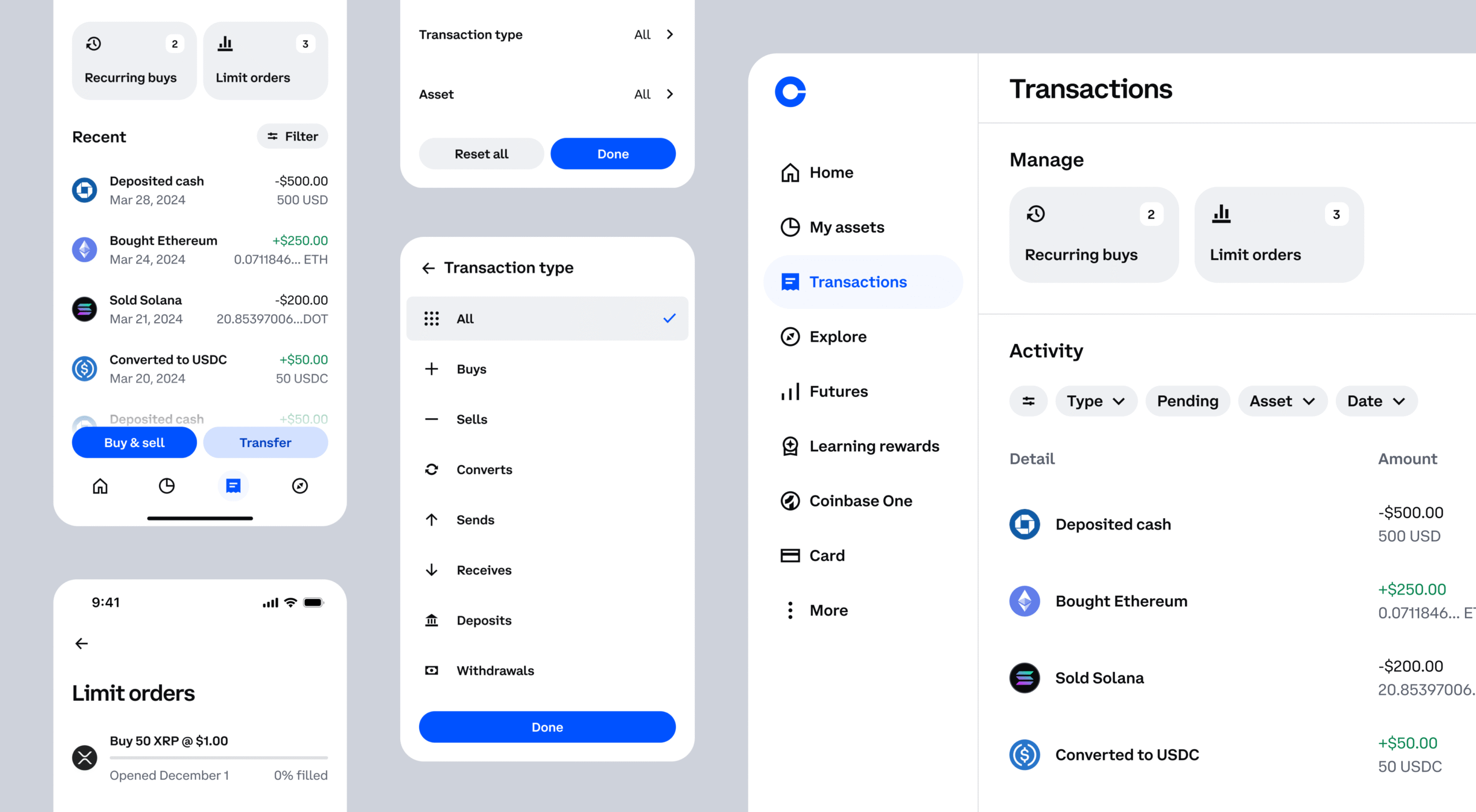
Coinbase is widely known for its simple and intuitive layout. In 2025, they’ve updated the app with clearer icons, larger fonts, and guided tutorials for staking, buying, and selling. You’ll find:
- A “For You” dashboard that recommends crypto content based on your portfolio.
- One-click access to Buy/Sell, and a dedicated Staking tab.
- “Learn & Earn” videos that teach and reward you in real tokens.
Perfect if you want your first experience to be calm, safe, and educational.
Robinhood: Minimal, but Limited in Features

Robinhood offers one of the sleekest interfaces in the fintech world. Buying Bitcoin feels like buying a stock. It’s fast, beautiful, and fluid. Charts respond instantly, and everything is tap-based.
However, crypto features are limited. You can’t stake, send crypto to another wallet, or explore on-chain actions. It’s great for simplicity, but not built for full crypto engagement.
BitGlide: Modern and Feature-Rich
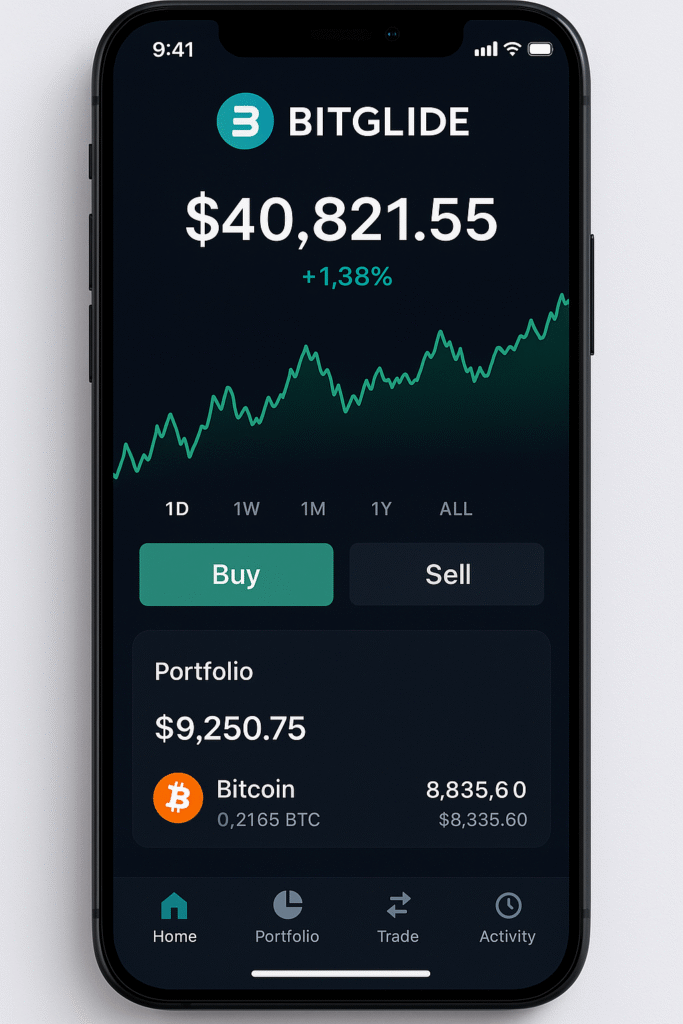
BitGlide’s UI feels like the next generation of crypto apps. It’s animated, customizable, and includes:
- Real-time APY trackers
- Multi-token staking in one dashboard
- Alerts for high-yield opportunities
It’s incredibly powerful but may feel overwhelming for total beginners. Still, if you’re tech-savvy or curious, you’ll love how interactive it feels.
✅ Verdict:
Best for APY hunters & explorers: BitGlide
Best for beginners: Coinbase
Best for simplicity: Robinhood
🔐 Safety & Security: How to Choose Safely
When it comes to crypto, safety isn’t optional — it’s essential. You’re not just trading internet money; you’re handling real financial assets that are vulnerable to hacks, scams, and poor security practices.
Let’s break down how secure each platform really is in 2025.
Coinbase

Coinbase has always taken compliance seriously. It’s a public U.S. company and is regulated under FinCEN and state money transmission laws. Security features include:
- 98% of assets stored in cold wallets
- FDIC insurance up to $250,000 on USD balances
- Two-Factor Authentication (2FA) and device management
- Email confirmations for withdrawals
If Coinbase is ever compromised, users are more likely to get reimbursed due to its insurance policies and strict internal protocols.
🛡️ Kraken’s 2025 Institutional Report named Coinbase as one of the top 3 most secure platforms for retail users in North America.
Robinhood

Robinhood is regulated by the SEC and FINRA, but its crypto arm operates under separate terms:
- Crypto holdings are not FDIC or SIPC insured
- Good basic protections: 2FA, withdrawal limits, identity verification
- History of outages and restricted access during high-volume events (notably in 2021 and again briefly in late 2024)
While it’s fine for casual trades, it lacks deep crypto security measures.
BitGlide
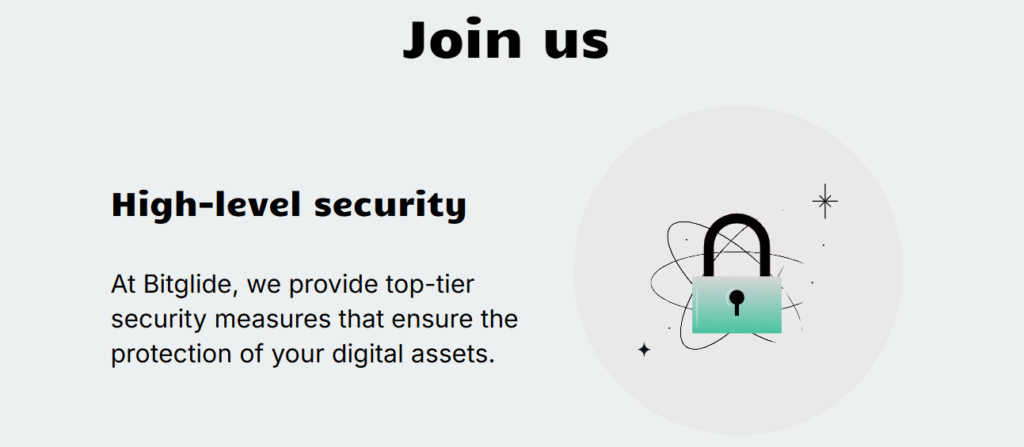
BitGlide claims:
- 256-bit SSL encryption
- Multi-signature wallets
- Custody partnership with a Swiss-based firm
However, they’re still new. As of July 2025:
- No public security audit has been released
- No official U.S. licenses yet filed
They’ve had no known hacks — but it’s early days.
✅ Takeaway:
- Coinbase offers bank-grade security — perfect for beginners.
- Robinhood is okay for small trades but risky for larger crypto holdings.
- BitGlide is promising but needs time to prove itself.
Always use strong passwords, enable 2FA, and keep your recovery phrases offline — no matter which platform you choose.
Don’t know how to use crypto apps , Here is the guide – How to Use Crypto App for Beginners (2025)
🚀 How to Get Started with Coinbase, Robinhood & BitGlide (Step-by-Step for Beginners)
Starting with crypto in 2025 is easier than ever — but it’s important to follow the right steps to avoid mistakes and secure your funds. Here’s how to get started with Coinbase, Robinhood, and BitGlide, even if you’re totally new.
🟢 Getting Started with Coinbase
✅ Step-by-step:
- Go to coinbase.com or download the app from the App Store/Google Play.
- Sign up using your email and create a strong password.
- Verify your identity with a government ID (required in the U.S.).
- Link your bank account or debit card.
- Deposit funds and choose your first crypto (BTC, ETH, etc.).
- Optionally, activate staking on assets like ETH or ADA.
- Turn on 2FA (two-factor authentication) for security.
💡 Bonus: Use “Learn & Earn” on the app to earn free crypto while watching short videos.
🟢 Getting Started with Robinhood
✅ Step-by-step:
- Download the Robinhood app or visit robinhood.com.
- Create an account using your phone number and verify your identity.
- Connect your bank account.
- Deposit funds (typically $1–$1,000).
- Navigate to the “Crypto” tab and buy your first coin.
- Note: You can’t stake or withdraw crypto to an external wallet on Robinhood (as of 2025).
💡 Good for beginners who already trade stocks or ETFs and want to try crypto.
🟢 Getting Started with BitGlide
✅ Step-by-step:
- Visit bitglide.com or download the app.
- Sign up with email and phone, and complete KYC verification.
- Add USDC, USD, or crypto from another wallet.
- Explore staking options under the “Earn” or “Boost” tab.
- Choose tokens like SOL, DOT, or MATIC with high APY.
- Enable app alerts for price drops and APY spikes.
- Turn on 2FA for extra security.
💡 BitGlide may not be available in every U.S. state — check local availability.
🔐 Pro Tips for All 3 Platforms:
- Use a strong password + 2FA from day one.
- Start with $50–$100 to get comfortable.
- Use a crypto tracker app (like CoinStats or CoinMarketCap) to monitor your portfolio.
- Always read the fine print on staking and withdrawal terms
.
📱 Ease of Use: Which App Feels the Best?
If you’re new to crypto, the last thing you want is a confusing app. A smooth interface can turn a stressful experience into a confident one. Let’s compare how each app performs for beginners in terms of design, usability, and onboarding.
Coinbase
Coinbase is often praised for its clean design and educational focus. In 2025, the app includes:
- A “Learn & Earn” section with tutorials that reward you in crypto
- Beginner walkthroughs for first-time trades
- A clear portfolio dashboard showing live gains/losses
- One-click staking and recurring buy options
You can go from downloading the app to buying your first $50 of Bitcoin in less than 5 minutes. Even older users find the app friendly and intuitive.
Robinhood
Robinhood’s strength lies in its minimalist and responsive UI. It feels more like a social finance app:
- One-tap crypto purchase
- Smooth chart animations
- Clean profit/loss view
However, it lacks crypto-specific features like staking, wallet support, or blockchain education. It’s great if you just want to “buy and hold,” but offers very little beyond that.
BitGlide
BitGlide is designed for Gen-Z and Millennial users. In 2025:
- The app supports dark mode, animated insights, and in-app quizzes
- Wallet connections and staking flows are integrated into the home screen
- Customizable crypto watchlists and “APY boost” notifications
Some beginners might find the staking features a bit overwhelming at first — but the guided setup makes it manageable.
✅ Takeaway:
- Robinhood is the easiest to use but lacks depth
- Coinbase strikes the perfect balance of simple + powerful
- BitGlide is sleek and feature-rich, best for curious beginners willing to explore
🎯 How to Choose the Perfect Crypto App
Now that you’ve seen the head-to-head breakdown, how do you pick the app that’s right for you?
The answer depends on three things:
- Your investment style
- Your risk tolerance
- Your long-term goals
Consider These Scenarios:
- You’re completely new to crypto and want safety + staking:
Choose Coinbase. It’s regulated, beginner-friendly, and lets you earn from staking. - You’re already using Robinhood for stocks and want to dabble in crypto casually:
Stick with Robinhood. It’s easy, integrated, and you don’t need another app. - You’re excited by high returns and want to explore new platforms:
Go with BitGlide. Just remember: higher rewards often come with higher risk.
Here’s a quick comparison table to wrap it up:
| Need | Best Choice |
|---|---|
| Beginner-friendly UI | Robinhood |
| Highest APY | BitGlide |
| Proven security | Coinbase |
| Passive income/staking | Coinbase, BitGlide |
| Low fees | BitGlide, Robinhood |
| Regulated + insured | Coinbase |
📌 Don’t forget: You’re not locked in. You can try more than one app. Most people use 2–3 apps to take advantage of different features.
👥 Top User Reviews & Real Feedback
Stats are great, but what do real users say about these apps? We dove into Reddit threads, App Store reviews, and Twitter to understand what beginners and daily users think in 2025.
Coinbase
- ⭐ 4.5/5 App Store Rating
- Users praise its easy-to-navigate UI and clear staking process
- Common complaints: “Support is slow” and “Fees are too high”
📣 “I’ve used Coinbase since 2020. No issues with deposits or withdrawals. But I dread contacting support.” — Reddit user
📣 “Great for beginners but once you grow, the fees add up fast.” — Trustpilot
Robinhood
- ⭐ 4.1/5 App Store Rating
- Loved for its intuitive interface and zero-fee trading
- Complaints focus on lack of crypto features and poor handling of past outages
📣 “Robinhood is perfect for dabblers, but you can’t stake or send crypto. That’s a dealbreaker for me.” — Crypto Twitter
📣 “Switched to Robinhood for stocks, stayed for Bitcoin. Works well for basic needs.” — App Store review
BitGlide
- ⭐ 4.7/5 App Store Rating
- Early users appreciate the high APYs, modern UI, and fast onboarding
- Some raise questions about transparency and platform longevity
📣 “Best APY I’ve seen, and staking is so simple. Hope they last!” — Discord user
📣 “It’s too new to trust fully, but I’m cautiously optimistic.” — Reddit review
✅ Takeaway:
Each platform has strengths:
- Coinbase is dependable but expensive
- Robinhood is fast and free, but lacks crypto depth
- BitGlide is promising but still proving itself
Always check app store reviews before funding your wallet.
Want to know these two crypt app comparison, Here is the detail article – Webull vs Coinbase (2025): Which Crypto App is Better?
👤 Real User Case Studies
Case Study 1: Safe First-Timer
User: Melissa, 33, New Jersey
App: Coinbase
Goal: Earn passive income through staking
Result:
“I started with $250 in ETH on Coinbase. The app taught me how staking works, and I’ve made about $15 in rewards in 3 months. It’s not huge, but I’m learning and it feels safe.”
Case Study 2: Budget Conscious Trader
User: Brandon, 25, Texas
App: BitGlide
Goal: Maximize APY with limited capital
Result:
“I put $500 into DOT on BitGlide because they offered 8.5% APY. So far, no issues. The staking dashboard is super modern. I’m keeping an eye on it, but it’s my favorite app right now.”
Case Study 3: Casual Explorer
User: Ayesha, 29, California
App: Robinhood
Goal: Try crypto with her stock investments
Result:
“I already had Robinhood for stocks. So when I wanted to buy Bitcoin, it was convenient. But I was disappointed there’s no staking. I’ll probably switch once I get more serious.”
Quotes from trusted Sources About these Apps
✅ Coinbase: Trusted and Regulated
🗣️ From Coinbase Blog (2025):
“Security remains our #1 priority. Over 98% of customer funds are stored offline and protected by industry-grade encryption.”
— Coinbase Security Update, Q2 2025
🗣️ From Kraken 2025 Institutional Security Report:
“Among U.S.-regulated platforms, Coinbase ranks in the top 3 for overall retail asset protection and platform stability.”
— Kraken Intelligence, March 2025
🗣️ From Forbes Crypto:
“For beginners entering the crypto space, Coinbase remains the most reliable gateway due to its compliance-first approach.”
— Forbes Crypto, May 2025
✅ Robinhood: Familiar but Limited for Crypto
🗣️ From Robinhood Blog (2025):
“We’re building crypto access the same way we built stock investing — simple, mobile-first, and commission-free.”
— Robinhood Press Release, January 2025
🗣️ From Decrypt News:
“While Robinhood remains easy to use, its crypto offerings still lack the depth seen on more specialized platforms.”
— Decrypt, April 2025
🗣️ From The Verge:
“Robinhood users still can’t send crypto to external wallets — a major drawback for anyone looking to fully engage with blockchain ecosystems.”
— The Verge, June 2025
✅ BitGlide: Promising but New
🗣️ From BitGlide Official Blog (2025):
“Our mission is to unlock high-yield crypto tools for everyday investors — with zero-fee access and real staking rewards.”
— BitGlide Blog, February 2025
🗣️ From CoinDesk:
“BitGlide is catching attention for its DeFi-inspired staking model. But experts warn that without public audits, users should proceed with caution.”
— CoinDesk, March 2025
🗣️ From TechCrunch:
“BitGlide feels like the ‘Robinhood of DeFi’ — easy enough for beginners, but bold enough to challenge bigger players.”
— TechCrunch, May 2025
💬 My Personal Take: What Would I Choose in 2025?
If I had to pick just one app for starting out in 2025, I’d go with Coinbase.
Why? Because:
- It’s been around for over a decade.
- It’s fully regulated in the U.S.
- It offers real passive income through staking.
Yes, the fees are higher — but as a beginner, I’d rather pay a little more and sleep well knowing my crypto is safe, insured, and accessible.
That said, I’m also actively experimenting with BitGlide for its impressive APYs and modern tools. But I’m keeping my investments small there for now — just in case.
Robinhood? Great for stocks, yes. But in crypto, it feels like you’re always using the “lite” version. It’s fine if you’re curious, but you’ll outgrow it fast if you’re serious.
.
🧠 Final Thoughts: What’s the Verdict?
There’s no single “best” crypto app — it’s all about what you need.
Let’s recap:
- Coinbase is perfect for beginners who value security, regulation, and staking. It’s a bit pricey, but worth it for peace of mind.
- Robinhood is ideal for users who want simplicity and are already trading stocks. But its crypto features are limited.
- BitGlide is exciting for high-APY seekers and adventurous users. It’s feature-rich and sleek but still new and untested.
🔥 As Coinbase stated in a 2025 blog post:
“Crypto rewards those who are informed, cautious, and curious. Not just fast movers.”
👉 So here’s what you should do:
- Pick one app that matches your current comfort level.
- Start with a small amount (like $50–$100).
- Explore its features, learn how it works, and grow from there.
CryptoTrendd is here to help you make smarter crypto decisions, with guides, honest reviews, and the latest U.S. platform updates.
❓Frequently Asked Questions (FAQs)
1. Which app is best for beginners in the U.S.?
Coinbase is best if you want safety, staking, and a proven track record. Robinhood is good if you’re casually trying crypto for the first time. BitGlide is great for rewards but better for those who can handle a bit more risk.
2. Is staking safe on these apps?
Staking is generally safe on regulated platforms like Coinbase, where your crypto is held securely. BitGlide offers high yields, but since it’s a newer app, there’s more risk. Robinhood doesn’t offer staking.
3. Can I use more than one app?
Absolutely. Many investors use Coinbase for staking, Robinhood for quick trades, and BitGlide for high APY opportunities. Just keep track of where your funds are.
4. Are these apps legal in all U.S. states?
- Coinbase operates in all 50 states.
- Robinhood Crypto is available in most states but still restricted in a few.
- BitGlide is expanding state-by-state, so check your local availability.
5. What happens if my app gets hacked?
- Coinbase has insurance and FDIC backing for USD.
- Robinhood does not insure crypto holdings.
- BitGlide has no public insurance or recovery guarantees yet.
💬 Have a favorite app already? Drop a comment or tweet us your experience — we might feature it in our next blog!
Follow Us On Social Media

5 Comments